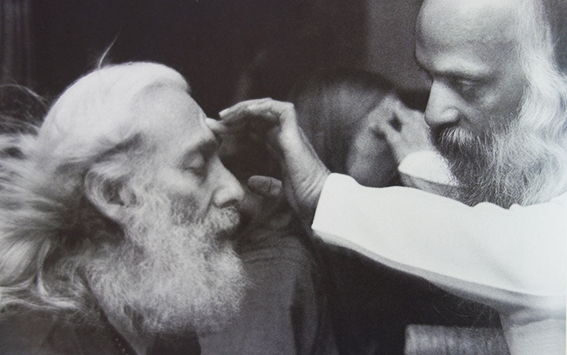Osho moves to Pune, where he establishes the Shree Rajneesh Ashram to put into practice this vision.
The Ashram grows exponentially, and within just a few years over one hundred thousand people pass through its gates. There are over 700 permanent residents, from all over the world, living and working in the Ashram. And thousands of visitors come for shorter stays.
It is a vibrant, intense and exciting place. The day begins at 6am with Dynamic Meditation, followed by an Osho discourse at 8am. It ends with evening darshan with Osho, followed by Music Group, where everyone celebrates with singing and dancing. During the day, the residents work and the visitors either meditate or do workshops.
The people who come are young and well educated, and disillusioned with the life they had been expected to live. They want something more – they feel there has to be more to life than the rat race. And they find it in the Ashram, which is a boiling pot of intense immersion in Osho’s talks, his meditation techniques plus the new psychotherapy techniques emerging from the West.
Contemporary journalists describe them as ‘an exceptionally fine crop’ (The Times), and ‘some of the best talent under one roof any institution could boast of‘. ‘[Osho] has attracted to his teachings some of the best educated minds of Western Europe and the US.’
Therapists and psychologists from all over the world come to visit, and many stay. As one journalist writes: ‘What impressed me most during my first visit was that all these therapists – well-known, the avant-garde in their own countries – had left their professions and their riches to work in the ashram where they receive two meals a day, a bed, a free-pass for [Osho’s] discourses and nothing else.’ More.
Osho encourages them to create workshops which combine Eastern meditation techniques with Western psychotherapy, and by 1980 this international community has gained a reputation as ‘the world’s finest growth and therapy center’. Contemporary accounts from journalists who spend time there describe the Ashram as ‘the biggest spiritual supermarket in the world’. Read some of their accounts here.
During these seven years Osho gives a 90-minute discourse every morning, alternating each month between Hindi and English. A huge Buddha Hall is built to accommodate the thousands who come every morning to listen to him.

His discourses offer insights into all the major spiritual paths, including Yoga, Zen, Taoism, Tantra and Sufism. He also speaks on Gautam Buddha, Jesus, Lao Tzu, and other mystics. These discourses are collected into over 600 books and translated into 50 languages. Osho himself designs the covers for his books.
His discourses are described by visiting journalists as ‘dazzling’, ‘extraordinary’, ‘amazing’, ‘brilliant’, ‘charismatic’. Bernard Levin, of The Times of London, writes that Osho is ‘one of the most remarkable orators I have ever heard’.
Here is how these talks are described by contemporary journalists.
In the evenings, he answers questions on personal matters such as love, jealousy, aloneness, meditation, fear and death. These ‘darshans’ are compiled in 64 darshan diaries, of which 40 are published. Towards the end of this period, he begins to give ‘energy darshans’ where he transmits shaktipat energy without words.
In the international media Osho is described by contemporary journalists who actually spend time checking him out as ‘extraordinary’, ‘remarkable’, ‘deeply impressive’, ‘inspired’, ‘highly disturbing’, and ‘utterly fascinating’.
Alongside meditations and dancing and listening to Osho, the ashramites work – in the kitchen, as cleaners, as handymen, in the book publishing or audio departments, in the carpentry shop, in the medical centre, fashioning robes, in the jewellery or pottery centres, in the music and theatre departments or leading workshops. The Ashram activities are described by journalists here.
For a more complete and illustrated account of life in the Ashram, see The Sound of Running Water.







No Comments Found